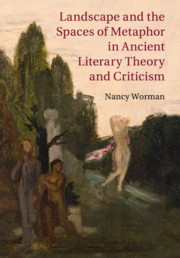
-
Select format
-
- Publisher:
- Cambridge University Press
- Publication date:
- December 2015
- December 2015
- ISBN:
- 9781139032827
- 9780521769556
- 9781108814478
- Dimensions:
- (247 x 174 mm)
- Weight & Pages:
- 0.83kg, 378 Pages
- Dimensions:
- (244 x 170 mm)
- Weight & Pages:
- 0.67kg, 382 Pages
You may already have access via personal or institutional login
Book description
This study explores a previously uncharted area of ancient literary theory and criticism: the ancient landscapes (such as the Ilissus river in Athens and Mount Helicon) that generate metaphors for distinguishing styles, which dovetail with ancient conceptions of metaphor as itself spatial and mobile. Ancient writers most often coordinate stylistic features with country settings, where authoritative performers such as Muses, poets, and eventually critics or theorists view, appropriate, and emulate their bounties (for example springs, flowers, rivers, paths). These spaces of metaphor and their elaborations provide poets and critics with a vivid means of distinguishing among styles and an influential vocabulary. Together these figurative terrains shape critical and theoretical discussions in Greece and beyond. Since this discourse has a remarkably wide reach, the book is broad in scope, ranging from archaic Greek poetry through Roman oratory and 'Longinus' to the reception of critical imagery in Proust and Derrida.
Contents
Metrics
Altmetric attention score
Full text views
Full text views help Loading metrics...
Loading metrics...
* Views captured on Cambridge Core between #date#. This data will be updated every 24 hours.
Usage data cannot currently be displayed.
Accessibility standard: Unknown
Why this information is here
This section outlines the accessibility features of this content - including support for screen readers, full keyboard navigation and high-contrast display options. This may not be relevant for you.
Accessibility Information
Accessibility compliance for the PDF of this book is currently unknown and may be updated in the future.


